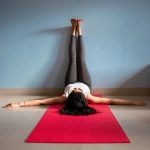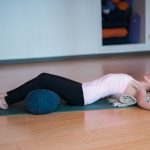How Yoga Can Improve Your Sleep Quality

You can improve your sleep just by implementing bedtime yoga sequences into your daily practice. Yoga for better sleep can be done from the comfort of your own bed.
Improved sleep is one of the best benefits of a yoga practice. Here are some specific ways to use yoga for better sleep.
Regular Yoga Practice Leads to Better Sleep
Let’s start with the basics. Having any type of yoga as a regular part of your routine can help you sleep better. It’s exercise, after all, and many studies have shown that regular exercise helps with sleep.
Some styles of yoga are more intense—Power or Vinyasa yoga feels like more of a workout. Other styles are gentler, less intense, but more focused on calming the nervous system.
While you can do Vinyasa yoga every day, it might not be advisable. Intense work on the muscles, especially when there is a lot of stretching involved, can lead to pain and injury. Power or Vinyasa styles are best for most bodies between one to three times a week, especially when mixed with other forms of exercise like Pilates and cardio.
Gentler forms of yoga, like some Hatha classes and Restorative yoga classes, can be done daily (and can be magical for sleep improvement as well as pain relief). Even a daily 10-20 minute routine to wake up in the morning or wind down at night can go a long way.
Yin yoga is also wonderful, but this deep stretching practice should be complemented by strengthening exercises and cardio and should not be practiced more than three times a week. During the online yoga course under the guidance of highly trained and experienced yoga masters, you work immensely on enhancing your practice.
Experiment with different styles to see what works for your yoga for better sleep practice.
Calming Bedtime Yoga Sequences
Yoga practice before bed is especially helpful for some. Stretching out tight muscles from sitting all day can help with feeling comfortable in bed at night, and a brief sequence to help deepen the breath can aid with transitioning from the daytime to sleep time and calming the nervous system enough to go to sleep.
My favorite simple yoga for sleep sequence is the Moon Salutation. Here is a primer I wrote on this sequence.
Many other calming yoga for better sleep sequences are online. Even a few of your favorite calming poses will work. There’s no magic sequence that works for everyone all the time.
Legs Up the Wall
Legs Up the Wall might be the most classic of the Restorative postures. If you only have time for one pose, this one is known to be very effective for calming the nervous system. It also has other benefits, like taking the pressure off the feet, soothing the lower back, and massaging the internal organs with gentle inversion. (It’s also something most of us can do at home with a wall, a couch, a chair, or pretty much anything you can swing your legs over.)
Note: Legs up the wall bedtime yoga may not be appropriate during pregnancy, after certain surgeries, or if you have conditions that counterindication laying on the back or inverting.
If you have a tendency to have a pretty high-strung nervous system and you have a hard time relaxing, practicing this every day (any time of day) will help to slow you down and get you into a calmer habit of mind, which will aid sleep over time.
To do the pose:
- Lay on your side with your bum as close to a wall or couch as you can get it.
- Hug your knees in close, and then roll onto your back so you can extend your legs up the wall or swing them over the couch.
- (optional) Make it even more restorative by placing a cushion or bolster under your hips, a rolled towel or blanket behind your neck, an eye pillow over your eyes, and a hot water bottle on your belly, chest, or feet.
- Stay for five to 20 minutes.
Also Read: HOW TO USE YOGA TO BOOST YOUR STAMINA
Yogic Breathing
Breathing intentionally is a great way to use yoga for better sleep.
There are many ways to breathe, and it’s best to find what works for you. I like a simple combination of belly breathing and “stretching” the breath:
- Start with three big sighs, which will begin to help calm the nervous system.
- Then focus on relaxing your low belly and your pelvic floor. Allow your breath to move down deep into the belly, feeling it expand and rise on your inhale and soften and relax as you exhale.
- As you do this, very gently “stretch” the breath: Allow your inhales to be slightly longer than they would naturally be, and allow your exhales to be slightly longer than they would naturally be. (Note: If this causes any stress or strain at all, skip this part and only focus on the belly rising and falling, relaxing the abdomen as much as you can.)
If you would like a guided meditation with the breath, try this guided meditation for deep sleep with breathwork.
Also Read: How meditation can change your life?
Restorative Yoga in Bed
Sometimes when you are laying awake at night, it’s best to give up on sleep and focus on rest instead. Rest is almost as good as deep sleep, and we often make things worse for ourselves when we watch the clock and get frustrated that we can’t drift off. Practicing some restorative postures in bed can be a nice way to focus on relaxing and calming the body. Trust in the medicine of that rest, even if it’s not full-on sleep. Combine this with belly breathing for the best effect.
Here are two yoga poses for better sleep:
Side-lying Savasana:
- Put a pillow under your head, under your side body, and between your legs, laying on your side.
- Your shoulder should drop between the two upper pillows.
- You can have your knees together or slide the bottom leg to straight if it’s more comfortable.
- Focus on breathing into your upper side.
Babbling Brook Pose:
- From Side-lying, you can roll onto your back, so that you have a pillow under your head and a pillow under your upper back.
- Allow your shoulders to relax into the space between the pillows.
- Legs could rest over top of the third pillow, or you could take butterfly legs if you like that better.
- Focus on breathing into the heart and belly.
It’s okay to fall asleep in any of these shapes. If you’re still awake, you can simply roll to the second side of the Side-lying pose. If you don’t get to it, that’s fine too.
Guided Meditations for Better Sleep
Pair your yoga for sleep practice with a guided meditation. The right voice and meditation can help distract your mind from whatever worries might be keeping you up and help calm your body enough to drift away to sleep. Also if you are interested taking online yoga programs start your learning now at home without going to anywhere.
Try the Moonlit Pond, and the Starry Night, which are gentle fantasy meditations, or Guided Relaxation for Deep Sleep which uses the body scan to help the body drift off into dreamland.


